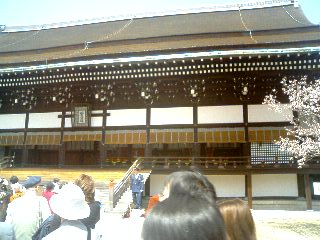<Until 5th century: Ancient (Jomon, Yayoi, and Kofun) period>
In this period, people are engaged in farming at small village and there is no central government of Japan.
The representative ruins of this period are the Yoshinogari ruin in Saga prefecture and Toro ruin in Shizuoka prefecture.
http://minkara.carview.co.jp/userid/269753/car/163271/1040566/photo.aspx
<From 6th to 8th C: Nara period>
The central government appeared in Nara prefecture.
The representative remains of this period is Todaiji temple. The emperor built the Great Buddha for suppressing the disaster such as famine and unusual weather.
<From 8th to 12th C: Heian period>
The capital was moved to Kyoto by emperor in order to avoid power of monk in Nara.
At first half of this period, the emperor and noblemen kept on having centre of power.
Kyoto Gosho, this is an imperial place, and many temples such as Shorenin, Byoudouin, and Daikakuji are built in this period.
At latter half of this period, power of samurai became strong because the emperor and noblemen needed them for power struggle.
The representative samurai is Tairano Kiyomori, and he built Itsukushima Shrine, which is one of the three most scenic spots in Japan nowadays, in Hiroshima prefecture.
<From 12th to 14th C: Kamakura period>
After Tairano kiyomori died, Minamotono Yoritomo became shogun. He moved to Kamakura in Kanagawa prefecture and administered affairs of state there.
Tsuruoka Hachiman shrine is guardian deity of samurai in Kamakura.
<From 14th to 16th C: Muromachi and Warring States period>
Ashikaga Takauji destroyed Kamakura shogunate and started Muromachi shogunate at Kyoto.
Kinkakuji temple was built at first half of this period and Ginkakuji temple was built at latter.
In fact, Ginkakuji temple was supposed to be coated with Silver. However, at that time, the shogunate declined and didn't have enough money to do that.
In contrast, power of samurai at each district became stronger. They warred to extend their territory, this is called Warring States period. Some castles are still remaining.
Eventually, Toyotomi Hideyoshi achieved unification of the whole country. He built Osaka castle in Osaka prefecture.
https://ja.wikipedia.org/wiki/%E5%A4%A7%E5%9D%82%E5%9F%8E
<From 16th to 19th C: Edo period>
After Toyotomi Hideyoshi died, Tokugawa Ieyasu became shogun and moved to Edo (now referred to as Tokyo).
Asakusa, which is popular place for tourists, developed at this period.
Many buildings of Edo period are still remaining around Japan.
Kurashiki in Okayama prefecture.
Shirakawago in Gifu prefecture.
Nijo castle at Kyoto is the place where the last shogun of this period declared to reply administration to emperor.
<From 19th to 21th C: Modern and Present period>
The Emperor moved to Tokyo and capital was set there. After that, Japan developed industry in order to catch up with Europe and United States.
In Japan, there are many sightseeing spots which are related to history, so maybe you can enjoy more with knowledge above.
















No comments:
Post a Comment